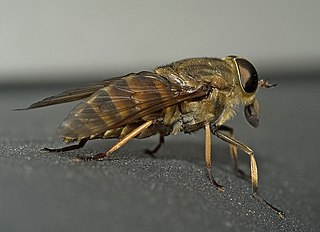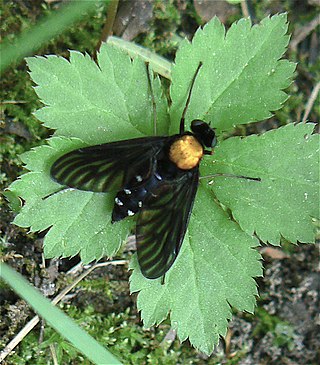
The Brachyceran infraorder Tabanomorpha is a small group that consists primarily of two large families, the Tabanidae and Rhagionidae, and an assortment of very small affiliated families, most of which have been included within the Rhagionidae.

The Brachyceran family Vermileonidae is a small family of uncertain affinities and unusual biology. It includes fewer than 80 described species, most of them rare and with restricted distribution, in 10 genera. Historically the vermileonids had been regarded as belonging to the family Rhagionidae, possibly in a subfamily Vermileoninae. Their biology and morphology are so markedly distinct from the main Rhagionidae sensu stricto however, that the placement as a separate family has been widely accepted.

Chrysopilus is common, worldwide genus of predatory snipe flies. There are approximately 300 species in the genus, including fossil members that are sometimes found in amber.

Rhagionidae or snipe flies are a small family of flies. They get their name from the similarity of their often prominent proboscis that looks like the beak of a snipe.

Rhagio is a worldwide genus of predatory snipe flies. Several species in this genus are referred to as downlooker or down-looker flies because they sometimes perch on tree trunks in a head-down position. There are approximately 170 species. They can be distinguished from other rhagionids by the open anal cell on the wings and the lack of a kidney-shaped arista.

Athericidae is a small family of flies known as water snipe flies or ibis flies. They used to be placed in the family Rhagionidae, but were removed by Stuckenberg in 1973. They are now known to be more closely related to Tabanidae. Species of Athericidae are found worldwide.

Symphoromyia is a genus of predatory snipe flies. Unusually for Rhagionids, some species of Symphoromyia are known to feed on mammal blood, including human blood. Symphoromyia species are stout bodied flies from 4.5 to 9 mm and with a black, grey or gold thorax, and the abdomen is coloured grey, black, or both black and yellow, black terminating with yellow, to completely yellow. The wings are hyaline or lightly infuscate.
Austroleptis is a genus of snipe flies, and the sole genus in the family Austroleptidae; until 2010, it was placed in the family Rhagionidae. They are small to moderately sized flies of around 3 to 7.7 mm.

Bolbomyia is a genus of snipe flies, and the sole genus in the family Bolbomyiidae; until 2010, it was placed in the family Rhagionidae. They are a small 2 to 3.5 mm, brown or black in color, with lightly infuscate (darkened) wings. They are restricted to the north temperate region of North America and Russian Far East (Kamchatka).

Pelecorhynchidae is a small family of flies. All of the genera were originally placed in the family Rhagionidae, and their elevation to family rank has been controversial. Other phylogenetic analyses have supported Pelecorhynchidae as a distinct clade from Rhagionidae. The adults of Pelecorhynchus mostly feed on nectar of Leptospermum flowers. Larvae have been collected in the damp margins of swamp areas, where they feed on earthworms.
Chrysopilus velutinus is a species of snipe fly in the family Rhagionidae.

Chrysopilus fasciatus is a species of snipe fly in the family Rhagionidae.
Chrysopilus griffithi is a species of snipe fly in the family Rhagionidae.
Chrysopilus pilosus is a species of snipe fly in the family Rhagionidae.

Chrysopilus basilaris is a species of snipe fly in the family Rhagionidae.
Chrysopilus tomentosus is a species of snipe flies in the family Rhagionidae.

Chrysopilus thoracicus, the golden-backed snipe fly, is a species of snipe fly in the family Rhagionidae.

Chrysopilus quadratus is a species of snipe fly in the family Rhagionidae.
Chrysopilus proximus is a species of snipe fly in the family Rhagionidae.

Chrysopilus connexus is a species of snipe fly in the family Rhagionidae.












